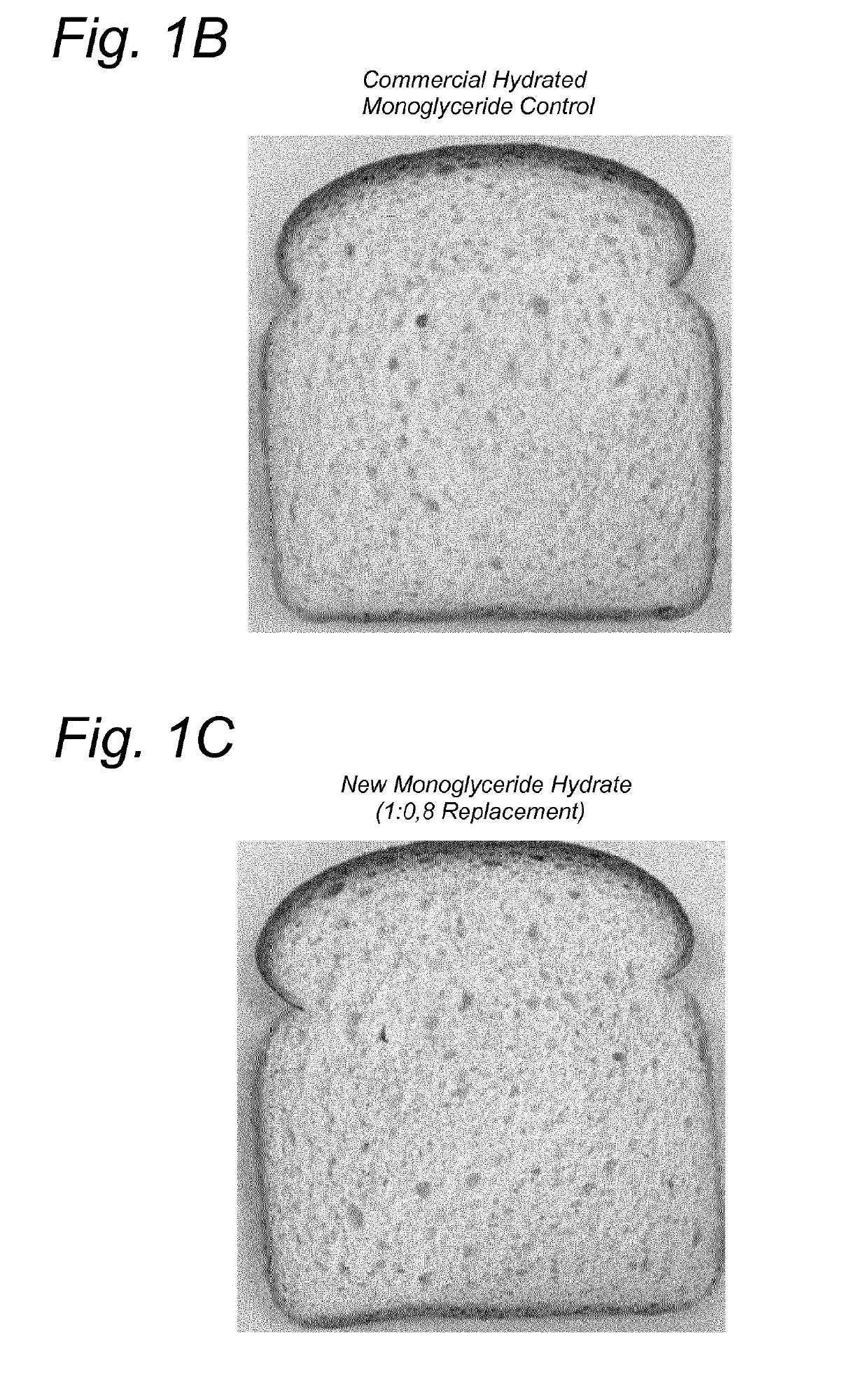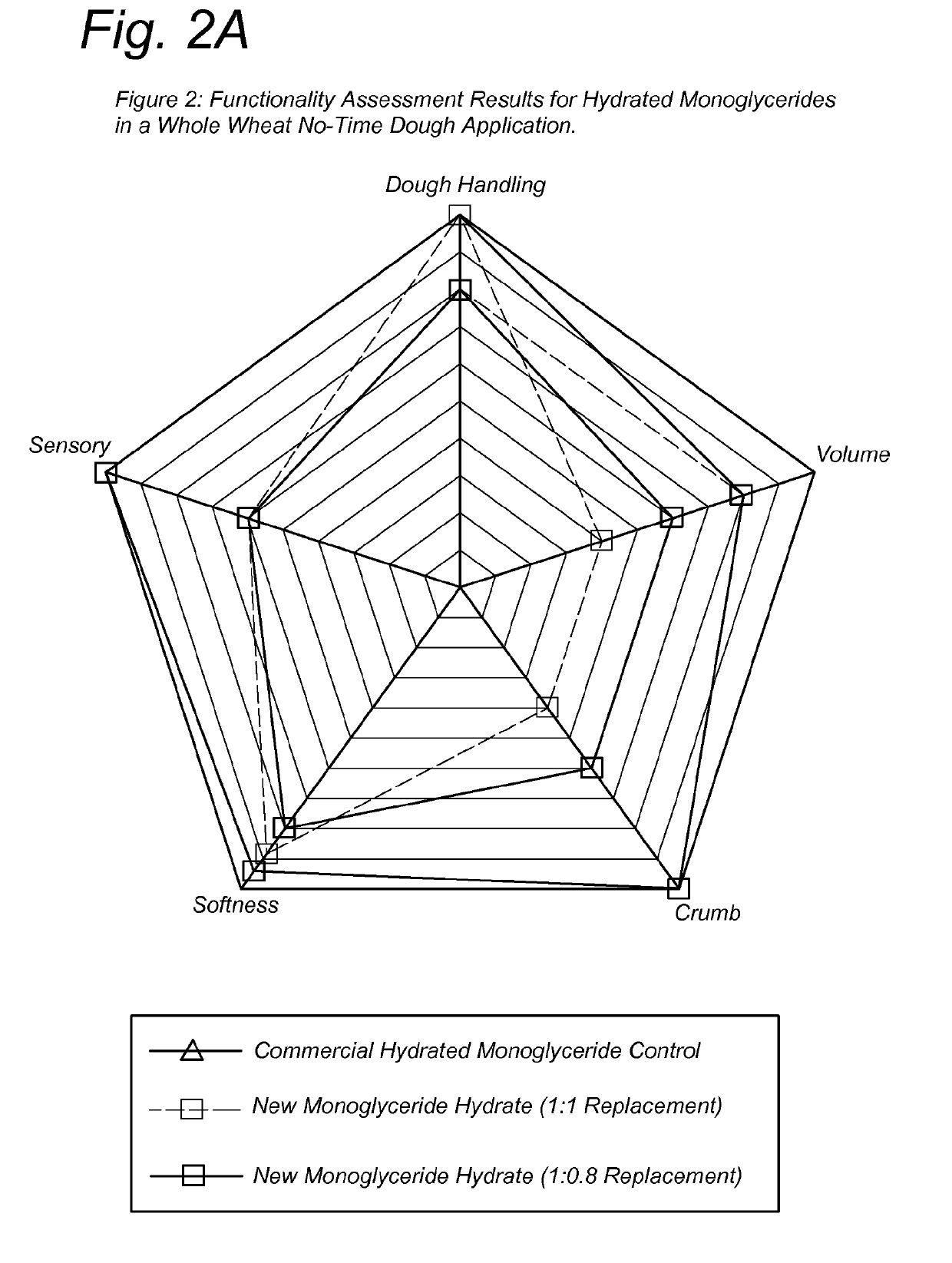Method for the preparation of a monoglyceride hydrate product
- Summary
- Abstract
- Description
- Claims
- Application Information
AI Technical Summary
Benefits of technology
Problems solved by technology
Method used
Image
Examples
example 1
Hydrate Manufacturing Method (23.5% by Weight Saturated Monoglycerides Content)
[0094]58.75 g of a stearic acid based distilled monoglyceride were charged into a jacketed beaker maintained at 75° C. Once molten, the emulsifier was stirred at 500 rpm. 37.56 g of room temperature deionized water were added slowly to the stirred emulsifier. After addition, the mixture was stirred for 5 min before the temperature was lowered to 60° C. An additional 139.75 g of room temperature deionized water were then added and mixed for 10 min. The temperature was further lowered to 40° C. and stirred for 10 min. After reaching the targeted temperature, 2.50 g of an oleic acid based monoglyceride co-emulsifier with an iodine value of approximately 80 was blended into the gel, and the system mixed for 15 min prior to addition of 11.44 g of acidified water (11.4% propionic acid / 0.85% phosphoric acid) for preservation. The resulting product was a smooth (i.e. it did not comprise particles with a size larg...
example 2
Hydrate Manufacturing Method (38.3% Saturated Monoglyceride Content)
[0095]153.13 g of molten stearic acid based distilled monoglyceride were charged into a jacketed beaker maintained at 75° C. The stirrer was set to mix at 500 rpm throughout the preparation. 98.15 g of room temperature deionized water were added slowly to the stirred emulsifier. After addition, the mixture was stirred for 5 min before the temperature was lowered to 64° C. An additional 107.55 g of room temperature deionized water were then added and mixed for 10 min. The temperature was further lowered to 40° C. and stirred for 10 min. After reaching the targeted temperature, 22.88 g of an oleic acid based monoglyceride co-emulsifier with an iodine value of approximately 80 was blended into the gel, and the system mixed for 15 min prior to addition of 18.30 g of acidified water (11.4% propionic acid / 0.85% phosphoric acid) for preservation. The resulting product was a smooth, thick paste with no signs of phase separa...
example 3
plication Test Procedures
[0096]A. Bread Volume Evaluation
[0097]The volume of each loaf of bread was measured using a Stable Micro Systems, Ltd (Godalming, Surrey, UK) VolScan Profiler 600, which uses a laser-based scanner to generate a 3-D image of the loaf from the measurement of 400 data points collected per revolution. The volume of the bread was evaluated for size, oven spring, and shape uniformity.
[0098]B. Sensory Evaluation
[0099]The organoleptic properties of each loaf were evaluated by trained panelists on day 3 and day 7 after baking. The panelists evaluated each loaf according to taste, aroma, mouth feel, crumb texture, crumb color, crust color, break and shred, and symmetry shape.
[0100]The results from each sensory test were evaluated statistically using standard one-way analysis of variance (ANOVA) and Duncan's multiple range test. The analyses were performed using the SPSS Inc. (Chicago, Ill.) SPSS v. 9 statistical software. Differences between samples were deemed signif...
PUM
 Login to View More
Login to View More Abstract
Description
Claims
Application Information
 Login to View More
Login to View More - R&D
- Intellectual Property
- Life Sciences
- Materials
- Tech Scout
- Unparalleled Data Quality
- Higher Quality Content
- 60% Fewer Hallucinations
Browse by: Latest US Patents, China's latest patents, Technical Efficacy Thesaurus, Application Domain, Technology Topic, Popular Technical Reports.
© 2025 PatSnap. All rights reserved.Legal|Privacy policy|Modern Slavery Act Transparency Statement|Sitemap|About US| Contact US: help@patsnap.com



